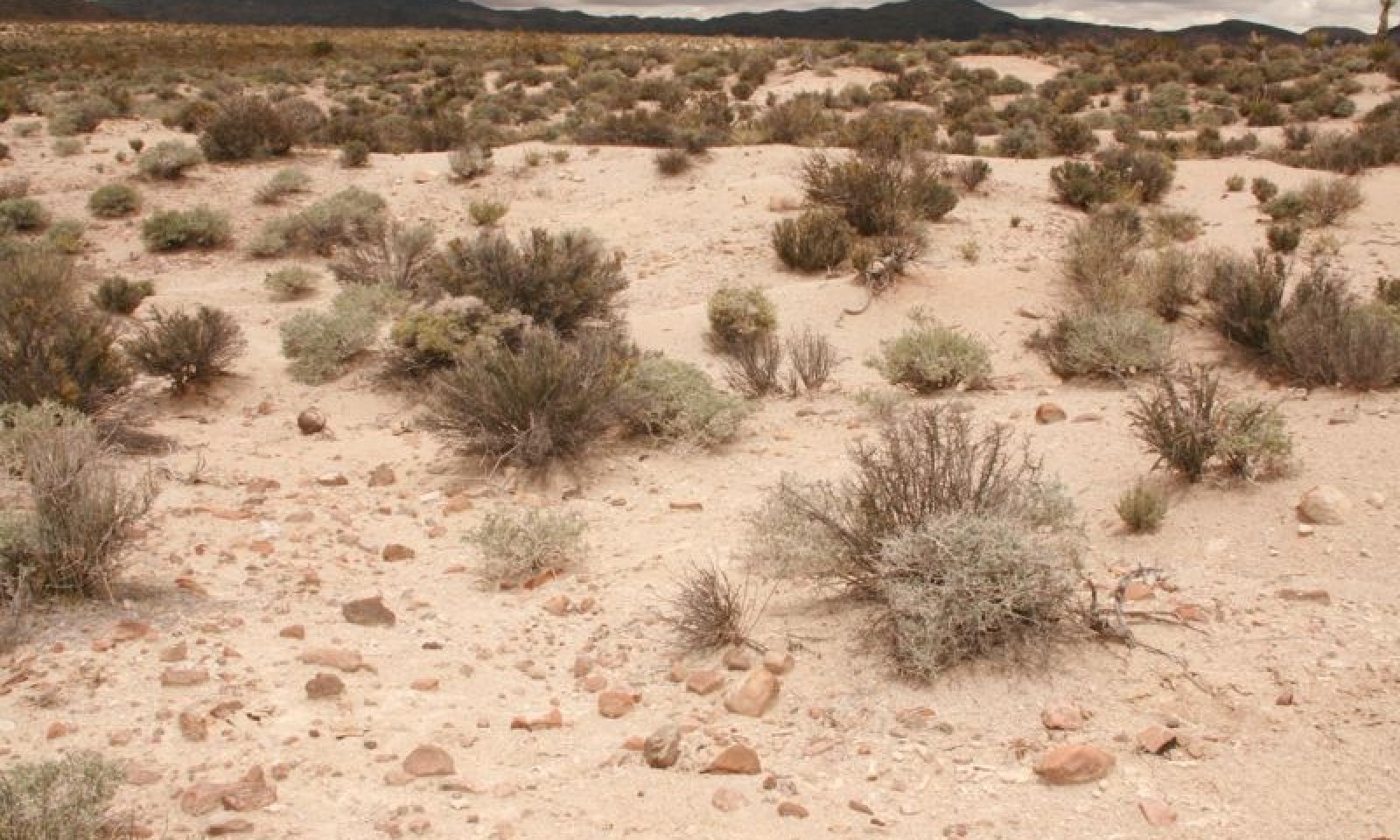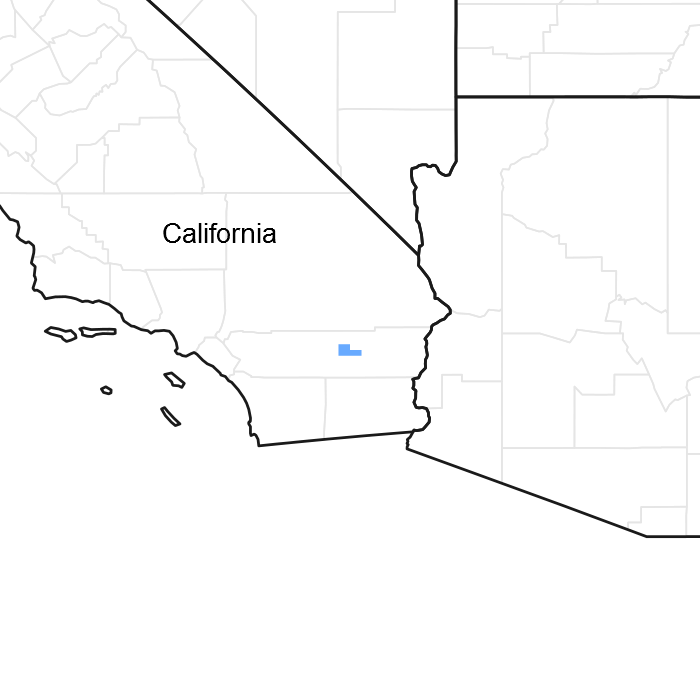

Natural Resources
Conservation Service
Ecological site R030XB221CA
Loamy Fan Remnants And Pediments
Last updated: 10/21/2024
Accessed: 12/22/2025
General information
Provisional. A provisional ecological site description has undergone quality control and quality assurance review. It contains a working state and transition model and enough information to identify the ecological site.

Figure 1. Mapped extent
Areas shown in blue indicate the maximum mapped extent of this ecological site. Other ecological sites likely occur within the highlighted areas. It is also possible for this ecological site to occur outside of highlighted areas if detailed soil survey has not been completed or recently updated.
MLRA notes
Major Land Resource Area (MLRA): 030X–Mojave Basin and Range
MLRA Description:
Major Land Resource Area (MLRA) 30, Mojave Desert, is found in southern California, southern Nevada, the extreme southwest corner of Utah and northwestern Arizona within the Basin and Range Province of the Intermontane Plateaus. The climate of the area is hot (primarily hyperthermic and thermic; however at higher elevations, generally above 5000 feet, mesic, cryic and frigid) and dry (aridic). Elevations range from below sea level to over 12,000 feet in the higher mountain areas found within the MLRA. Due to the extreme elevational range found within this MLRA, Land Resource Units (LRUs) were designated to group the MLRA into similar land units.
LRU Description:
This LRU (designated by ’XB’) is found across the eastern half of California, much of the mid-elevations of Nevada, the southernmost portions of western Utah, and the mid-elevations of northwestern Arizona. Elevations range from 1800 to 5000 feet and precipitation ranges from 4 to 9 inches per year, but is generally between 5-6 inches. This LRU is characterized primarily by the summer precipitation it receives, ranging from 18 – 35% but averages 25%. Summer precipitation falls between July and September in the form of rain, and winter precipitation falls starting in November and ends between February and March, also mostly in the form of rain; however it does receive between 0 and 3 inches of snow, with an average of 1 inch. The soil temperature regime is thermic and the soil moisture regime is typic-aridic. Vegetation includes creosote bush, burrobush, Nevada jointfir, ratany, Mojave yucca, Joshua tree, chollas, cactus, big galleta grass and several other warm season grasses. At the upper portions of the LRU, plant production and diversity are greater and blackbrush is a common dominant shrub.
This ecological site is found on eroded fan remnants and dissected pediments at elevations of 2230 to 4040 feet. Soils have a warm thermic temperature regime, loamy textures and have a well-developed argillic horizon beginning within 1 to 8 inches of the soil surface that occurs over hard bedrock or a duripan. This site is located close to the MLRA30-31 (Mojave – Lower Colorado Desert) boundary.
Production Reference Value (RV) is 297 pounds per acre and ranges from 195 to 402 pounds per acre depending on annual precipitation. The reference plant community is co-dominated by blackbrush (Coleogyne ramosissima) and burrobush (Ambrosia dumosa), and secondary shrub diversity is high. This ecological site is found at relatively low elevations for blackbrush in the Mojave Desert. A well-developed argillic horizon significantly increases soil moisture holding capacity, which allows blackbrush to be a dominant species despite low elevations. The argillic horizon also enhances habitat for the shallow-rooted burrobush. The transitional climatic location and dissected topography enhances shrub diversity.
Data in the following sections is based on all components (major and minor) correlated with this ecological site.
Ecological site concept
This ecological site is found on eroded fan remnants and dissected pediments at elevations of 2230 to 4040 feet. Soils have a warm thermic temperature regime, loamy textures and have a well-developed argillic horizon beginning within 1 to 8 inches of the soil surface that occurs over hard bedrock or a duripan. This site is located close to the MLRA30-31 (Mojave – Lower Colorado Desert) boundary.
Production Reference Value (RV) is 297 pounds per acre and ranges from 195 to 402 pounds per acre depending on annual precipitation. The reference plant community is co-dominated by blackbrush (Coleogyne ramosissima) and burrobush (Ambrosia dumosa), and secondary shrub diversity is high. This ecological site is found at relatively low elevations for blackbrush in the Mojave Desert. A well-developed argillic horizon significantly increases soil moisture holding capacity, which allows blackbrush to be a dominant species despite low elevations. The argillic horizon also enhances habitat for the shallow-rooted burrobush. The transitional climatic location and dissected topography enhances shrub diversity.
Data in the following sections is based on all components (major and minor) correlated with this ecological site.
This is a group concept and provisional STM that also covers R030XB075NV.
Associated sites
| R030XB218CA |
Moderately Deep To Very Deep Loamy Fan Remnants This ecological site is found on adjacent fan aprons on fan remnants. Burrobush (Ambrosia dumosa) and creosote bush (Larrea tridentata) dominate. |
|---|---|
| R030XB225CA |
Warm Sloping Pediments This ecological site occurs on adjacent shallow pediments. Burrobush (Ambrosia dumosa) and Hall's shrubby spurge (Tetracoccus hallii) dominate. |
| R030XB220CA |
Very Shallow Duripan Fan Remnants This ecological site is found on adjacent fan remnants with very shallow soils to a duripan. Sparse vegetation is dominated by burrobush (Ambrosia dumosa) and lotebush (Ziziphus obtusifolia). |
Similar sites
| R030XB220CA |
Very Shallow Duripan Fan Remnants This ecological site occurs on fan remnants with shallow soils to a duripan. Production is lower, blackbrush (Coleogyne ramosissima) is not an important species and burrobush (Ambrosia dumosa) and lotebush (Ziziphus obtusifolia) dominate. |
|---|---|
| R030XB166CA |
Dissected Pediment, Cool This ecological site is found on pediments at higher elevations. California juniper (Juniperus californica) is an important species and burrobush (Ambrosia dumosa) is trace if present. |
| R030XB189CA |
Shallow Cool Hills This ecological site is found on pediments at higher elevations and is co-dominated by creosote bush (Larrea tridentata). |
Table 1. Dominant plant species
| Tree |
Not specified |
|---|---|
| Shrub |
(1) Coleogyne ramosissima |
| Herbaceous |
Not specified |
Click on box and path labels to scroll to the respective text.


